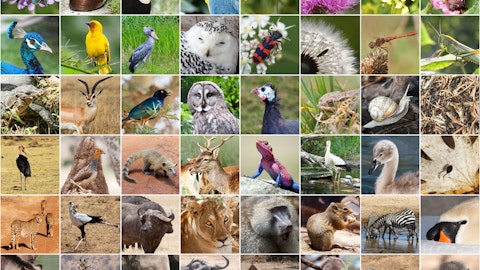What are the most biodiverse countries in the world? In today’s world, when plants and animals are disappearing faster than we’d like, it’s nice to see that some countries do their best to preserve the species they have in their territories, such as these 10 most biodiverse countries in the world.
What makes a country mega-diverse? Well, first of all, only a few countries in the world have enough biodiversity to rank this high. Biodiversity as a term includes all of the plant and animal species on the planet, with genetic differences, as well as the ecosystems where they can be found. In order for a nation to be on the mega-diverse list, they need to have at least 5,000 endemic plants and to have a marine ecosystem within its borders. Conservation International notes there are only 17 countries that fit the bill, accounting for 70% of the world’s flora and fauna. At the same time, their territories put together comprise under 10% of the world’s territory.

Pixeljoy/Shutterstock.com
If you like reading upon countries that differ from others in some way, don’t miss our article on 10 Most Barbaric Countries in the World.
In order to create our list today we took a look at these 17 countries and checked out how many types of plants, birds, mammals, amphibians and reptiles they have. Then, we ranked them by these, awarding points in accordance with their position on the chart. In the end, we added up the totals and came up with the 10 most biodiverse countries in the world.
10. Australia
Total – 48
First on the list of most biodiverse countries in the world is Australia, a rather large country with plenty of uninhabited land, which means it’s perfect for animals and plants to evolve and spread without much trouble. There’s a saying on the Internet about Australia, how everything there wants to kill you, what with the many animals and insects roaming around.
Well, Australia has over 34,000 plants – 20,000 vascular and 14,000 non-vascular – as well as an additional 250,000 species of fungi and 3,000 lichens. The list is just as diverse when it comes to animals, with 828 species of birds, 378 types of mammals, 207 species of amphibians and 440 types of reptiles.

Marco Saracco/Shutterstock.com
9. Venezuela
Total – 50
Venezuela is located in the northern area of South America. It is one of the most biodiverse countries in the world, with different habitats varying from mountain ranges, to rain forests, beautiful plains, and the Caribbean coast, as well as the spectacular Orinoco River Delta.
Venezuela his home to over 21,000 species of plants, 38% of which are endemic to the country. There are also a lot of species of animals across the country, including 1417 types of birds, 324 types of mammals, 315 species of amphibians and another 341 species of reptiles. It is also estimated that there are over 900 species of marine mollusks, 1,600 types of butterflies and over 120 dung beetle species, although the invertebrates groups aren’t all that well inventoried across the world.
There are 251 areas in the country that are protected by law, covering 54.1% of the country’s terrestrial area and 3.5% of the marine area.

8. Colombia
Total – 51
Next up on our list of most biodiverse countries in the world is Colombia, another nation that’s up in the northern area of the South American continent, right next door to Venezuela. The country’s flora is staggering, a whopping 130,000 species have been described here. Venezuela’s national flower is the beautiful orchid Cattleya trianae and the nation is home to the largest amount of endemic species, namely plants that are not found naturally anywhere else in the world.
When it comes to animals, there are over 1,800 species of birds, which is more than the number of species in North America and Europe combined, with the national bird being the Andean condor.
There are also 456 species of mammals reported in Colombia, nearly a quarter of them being on the endangered or critically endangered lists. There are also some 208 endangered species of amphibians living here and a few dozen species of reptiles.

Gokhan Bozkaya/Shutterstock.com
7. Peru
Total – 54
Peru ranks 7th on our list of the 10 most biodiverse countries in the world. Peru is also located in the western area of South America, bordering Ecuador and Colombia, as well as Brazil, Bolivia, and Chile, proving that this entire area is an extremely biodiverse location.
The country is home to 244 protected areas, covering 21.3 percent of the terrestrial area and 0.5% of the marine area.
Peru is home to over 13,000 types of flowers, and a very diverse fauna. Some 1,800 species of birds live here, as well as 500 species of mammals, 380 types of amphibians and 300 species of reptiles. Out of the many species of mammals, about 70 are endemic to Peru and over 100 are threatened or endangered. As far as the numerous bird species living here goes, more are still being discovered and cataloged.
The ecosystem variety and the country’s natural resources are recognized as a heritage in the country’s constitution.

nicolasdecorte/Shutterstock.com
6. India
Total – 54
India ranks 6th on our list of the 10 most biodiverse countries in the world. Located in South Asia, India is the seventh largest country by area and the second most populous nation in the world, with over 1.2 billion people living here. The country is located within the Indomalaya ecozone, containing three biodiversity hotspots.
India has one of the richest flora in the world, with over 45,000 species of plants here, many of whom are endemic. When it comes to fauna, India also has quite a diverse selection. Over 1,250 species of birds can be found here, as well as 410 species of mammals. Over 190 types of amphibians are located in India and another 408 species of reptiles.
India has 672 protected areas, covering 6% of the country’s terrestrial area and 0.2% of the marine area.

Eduard Derule/Shutterstock.com
5. Ecuador
Total – 57
Ecuador ranks 5th on our list of the most ecologically diverse countries in the world. On the western side of the South American continent, you’ll find Ecuador, a country that borders Columbia, Peru, and the beautiful Ocean. The nation is home to beautiful plants, over 16,000 species to be exact.
Ecuador is also home to some 1,600 bird species, including 38 more that are endemic to the Galapagos Islands. There are another 369 species of mammals here, 394 amphibian species and 415 species of reptiles. There are 74 protected areas across Ecuador’s territory, covering 20% of the terrestrial area and 13% of the marine area.
The Galapagos Islands, which are part of Ecuador, are particularly famous since the animals found here helped Charles Darwin start his theory of evolution by natural selection, one that is now studied across the world and held as true. The Islands are a World Heritage Site as recognized by UNESCO, a biosphere reserve, while 70,000 square kilometers (27,000 square miles) of ocean surrounding the islands form a marine reserve, the second largest in the world.

Marisa Estivill/Shutterstock.com
4. China
Total – 59
The second largest country by size, but the most populous in the world, with close to 1.4 billion people, China which ranks 4th in our list of most biodiverse countries in the world also has an extremely diverse flora and fauna. In fact, over 146,000 species of plants can be found on its territory, found especially in the subtropical forests on its territory. Over 30,000 of these plant species are endemic to China, representing about one-eighth of the total number of plant species in the world.
China is also home to over 1,200 types of birds, as well as 580 mammals, over 280 species of amphibians and some 376 species of reptiles. There are 2,158 protected areas across China’s vast territory, covering 17.1% of the terrestrial area and 3.8 percent of the marine area.

Hung Chung Chih/Shutterstock.com
3. Mexico
Total – 62
In the southern area of North America we find Mexico, a country that covers some 761,000 square miles. It’s a nation with a rich culture, full of history, ranking sixth in the world by the number of UNESCO World Heritage Sites.
Mexico ranks 3rd on our list of most biodiverse countries in the world. It is home to over 25,000 species of plants, ranking quite high among the world’s biodiverse nations. There are also 707 known species of reptiles living in its territory, as well as 438 species of mammals and 290 species of amphibians. About 2,500 species here are protected by Mexico’s laws.
Across the country’s territory, there are about 1,188 protected areas, covering 14.3% of the terrestrial area and 2.3% of the marine area.

ChameleonsEye /Shutterstock.com
2. Indonesia
Total – 63
Indonesia ranks second on our list of the 10 most biodiverse countries in the world. Indonesia is a transcontinental country located mainly in Southeast Asia, although some territories also cross into Oceania. There are some 360 million citizens spread over 735,000 square miles.
The country is also quite rich in plants and animals. How rich, you wonder? Well, the size of the country, mixed with the tropical climate and the local geography make up for the second highest biodiversity in the world. There are about 28,000 species of flowering plants, including 2,500 different orchids.
Nearly 1,600 species of birds found their home here, as well as over 515 species of mammals. Indonesia is also where you can find about 270 different types of amphibians and around 780 species of reptiles.

Fabio Lamanna/Shutterstock.com
1. Brazil
Total – 82
And we’re finally at the top of our list of most biodiverse countries in the world – Brazil – the most biodiverse country in the world. First off, Brazil is the fifth country in size, with a territory covering 3.2 million square miles, and fifth in population, with over 206 million citizens.
The large territory is home to many ecosystems, including the famous Amazon rainforest, which is the most biodiverse place on Earth. There are about 315,000 known species of plants here, about 55,000 being endemic to Brazil.
The country is also home to over 1,830 species of birds and 689 species of mammals. Brazil also ranks second with the most reptile species – 744.
Brazil has 2,190 protected areas, covering 28.9% of the terrestrial area and 1.7% of the marine area.
That being said, these are the 10 most biodiverse countries in the world.

Kanokratnok/Shutterstock.com





